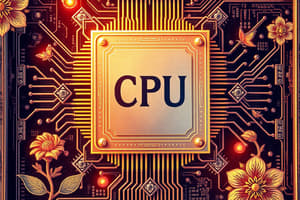Podcast
Questions and Answers
CPU-bound processes spend most of their time computing b) _______ processes spend most of their time waiting for I/O
CPU-bound processes spend most of their time computing b) _______ processes spend most of their time waiting for I/O
I/O bound
To increase CPU utilization and job throughput, previously covered the mechanisms of _______ switching
To increase CPU utilization and job throughput, previously covered the mechanisms of _______ switching
Context
Choosing which process to run next, when two or more of them are simultaneously in the ready state. Deciding which process should occupy the resource (CPU, disk, etc.). Done by scheduler using the scheduling _______
Choosing which process to run next, when two or more of them are simultaneously in the ready state. Deciding which process should occupy the resource (CPU, disk, etc.). Done by scheduler using the scheduling _______
algorithm
Many of the same issues that apply to process scheduling also apply to thread scheduling, although some are _______
Many of the same issues that apply to process scheduling also apply to thread scheduling, although some are _______
When a job exits, when a job blocks on I/O, when time slice expired, a hardware clock provides periodic interrupts, when a new job is created, whether to run the parent or the child, when an I/O interrupt occurs from an I/O device that has now completed its work for a waiting job. These are examples of when to _______
When a job exits, when a job blocks on I/O, when time slice expired, a hardware clock provides periodic interrupts, when a new job is created, whether to run the parent or the child, when an I/O interrupt occurs from an I/O device that has now completed its work for a waiting job. These are examples of when to _______
Interactive environments with users require that no process should be hogging the CPU and denying service to others. This is achieved through __________ scheduling.
Interactive environments with users require that no process should be hogging the CPU and denying service to others. This is achieved through __________ scheduling.
Real-time systems prioritize processes based on deadlines, using the __________ scheduling algorithm.
Real-time systems prioritize processes based on deadlines, using the __________ scheduling algorithm.
In Batch Systems, a scheduling algorithm where jobs are executed based on their arrival time is known as __________.
In Batch Systems, a scheduling algorithm where jobs are executed based on their arrival time is known as __________.
Non-preemptive scheduling allows the running process to keep the CPU until it voluntarily gives up the CPU, while preemptive scheduling allows for the running process to be interrupted and must release the CPU. This differentiation is based on __________.
Non-preemptive scheduling allows the running process to keep the CPU until it voluntarily gives up the CPU, while preemptive scheduling allows for the running process to be interrupted and must release the CPU. This differentiation is based on __________.
In Real-time Systems, a scheduling algorithm where jobs are treated equally and processed in order of arrival is the __________ scheduling.
In Real-time Systems, a scheduling algorithm where jobs are treated equally and processed in order of arrival is the __________ scheduling.
Flashcards are hidden until you start studying
Study Notes
Process Scheduling
- CPU-bound processes spend most of their time computing
- I/O-bound processes spend most of their time waiting for I/O
Scheduling Decisions
- Choosing which process to run next, when two or more are simultaneously in the ready state
- Deciding which process should occupy the resource (CPU, disk, etc.)
Performance Criteria
- Throughput: number of jobs completed in unit time
- Turnaround time: amount of time to execute a particular process from the time it entered
- Waiting time: amount of time process has been waiting in ready queue
- Meeting deadlines: avoid bad consequences
Scheduling Objectives
- Fairness: everyone is happy
- Priority: some are more important
- Efficiency: make best use of equipment
- Encourage good behavior
- Support heavy load
- Degrade gracefully: adapt to different environments
Categories of Scheduling Algorithms
- Batch: periodic tasks, no users impatiently waiting, possible to run for long time periods
- Interactive: for environments with interactive users, cannot be hogging the CPU
- Real-time: only programs that are intended to further the application, processes may not run for long and usually do their work and block quickly
Preemptive vs. Non-Preemptive Scheduling
- Non-Preemptive: running process keeps the CPU until it voluntarily gives up the CPU
- Preemptive: running process can be interrupted and must release the CPU
Scheduling Algorithm Goals
- Maximize throughput
- Minimize turnaround time
- Minimize waiting time
- Minimize response time
- Maximize CPU utilization
- Minimize context switching
Scheduling Algorithms
- First-Come, First-Served (FCFS): jobs are scheduled in order of arrival to ready queue, typically non-preemptive
- Short Job First (SJF): prioritize shorter jobs
- Round-Robin Scheduling: time slicing, each job gets a fixed time slice
- Priority Scheduling: prioritize jobs based on priority
- Multi-Queue & Multi-Level Feedback: multiple queues with different priorities and time slices
- Earliest Deadline First Scheduling: prioritize jobs based on deadline
Studying That Suits You
Use AI to generate personalized quizzes and flashcards to suit your learning preferences.




